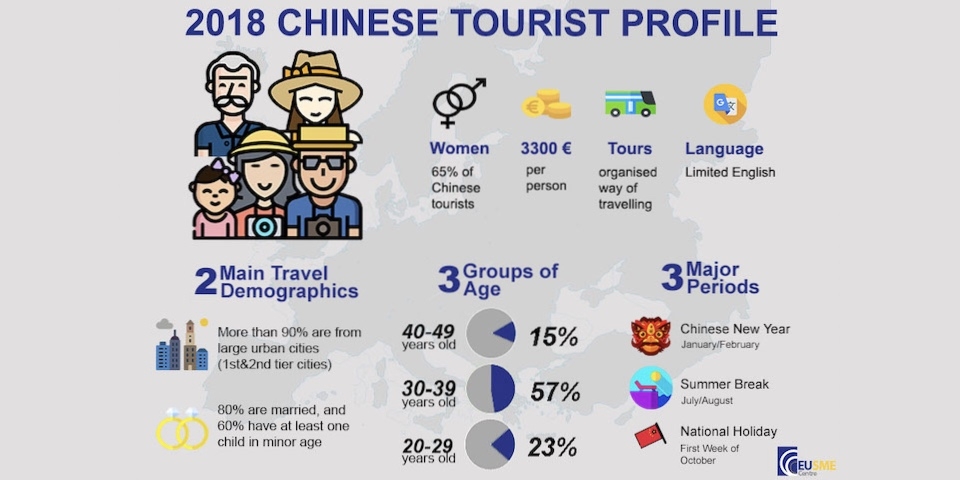


In 2016, European Commission’s President Jean-Claude Juncker, along with People’s Republic of China Vice-Premier Li Keqiang, announced 2018 as the “China-EU tourism year”, with adapted policies and effort to boost tourism on both sides. 2018 was indeed an important year for tourism with increasing number of Chinese tourists travelling abroad. Data show a growth of 5.1% of Chinese arrival in the EU and, according to Eduardo Santander, Executive Director of the European Travel Commission, “We will continue to see the benefits of the China-EU tourism year in 2019”.
For several years now, Europe ranks as the second favourite destination for Chinese tourists, and with more than 149 million overseas trips taken by Chinese in 2018, the market is expected to expand even more along with the growing middle class, despite the reports of an economic slowdown. According to the China Outbound Tourism Research Institute, the number of overseas trips taken by Chinese will surpass 400 million by 2030.
With such an immense market and a huge potential, Chinese outbound tourism is an opportunity but also a challenge for European SMEs, especially when it comes to understand Chinese tourists’ profiles and habits.
Chinese tourists do not come to Europe only to see and shop in capital cities: they like to explore hidden gems, local art and culture. Therefore, it is important for destination cities to find the right approach and campaign to market to the Chinese tourists who have other habits and user experiences than Western consumers.
Before building tailored content, a first step to market to Chinese tourists is to focus on the best ways to advertise your services towards the Chinese tourists. An example is the way QR-codes are used in China and in the European or Western hemisphere. A QR code is a two-dimensional barcode with a random pattern of tiny black squares against a white background, capable of holding 300 times more data than a traditional one-dimensional code
QR-codes are used as a bridge to connect the offline, real-life world with digital and online platforms and are an irreplaceable part of a Chinese daily routine. It is estimated that daily, users interact with QR codes 10-15 times. Thus, given the familiarity with QR-Codes, adding this routine into advertising or marketing to Chinese outbound tourists creates value to your content.
Five essential actions are made with QR-code in the Chinese digital eco-system: pay, connect, follow, access to information, register.
Within these 5 features, the use of QR codes covers almost all initial or final actions of a digital experience. The Danish capital city Copenhagen can be taken as example, The Smart QR Wall at Copenhagen airport was installed by the Danish media company NIHAO CPH, at the baggage claim area in spring 2018. Due to its position, it is the first advertisement Chinese tourists get exposed to when landing in the Danish capital city. Tourists can scan the QR-code while waiting for their luggage and get free guides, recommendations and information about the city.
At the base of Chinese marketing, there are two applications: WeChat and Alipay. These mobile phone’s applications are used for mobile payment by consumers and digital marketing by companies. China – more than any country on the globe – has started the transition to a cash-free economy with offline shops adapting to mobile payment systems. Shops in major European cities have started to integrate WeChat Pay or Alipay as a payment option for their Chinese customers. Chinese travellers now use their phones which get scanned by the shop to conclude a transaction.
KOLs to Tailor Your Marketing Campaign
Another way to reach out to younger outbound travellers is by creating trust and value by working with Chinese Key Opinion Leaders (KOLs) with large high numbers of followers and influence on a specific group. Young Chinese consumers are tech-savvy and use China’s unique social media platforms to share posts as well as follow influential people.
A campaign with KOLs, if done the right way, is relatively secure, with high return due to Chinese followers’ sense of community and trust. The key for a successful campaign is to choose the right niche KOL with the appropriate amount of engagement, the right location and focus. Agencies and platforms support brands in finding the right KOL, setting up a campaign, handling transactions and monitoring campaign results.
The EU SME Centre’s report “Digital Marketing Essentials for China” shares the practices in using KOLs and the average prices for those services. Nevertheless, the strongest asset of a strategy has to be based on accurate knowledge of market trends and customers profiles.
The Profile of a Chinese Outbound Traveler
Indeed, in many aspects, Chinese outbound travellers differ from European outbound travellers. Age, habits, seasons, budget, all those factors are crucial to understand and market Chinese tourists in Europe.
Three major periods are welcoming the largest part of 145 million overseas trips of Chinese tourists: Chinese New Year, Summer Break and days preceding and following Chinese National Day.
Several tendencies can be highlighted:
The tendency to travel with family or friends is also an important factor to consider. Indeed, quick, efficient and much cheaper, tours have a tremendous success among Chinese travelers, who are likely to visit several cultural attractions in a raw.
The different habits and profile of Chinese travelers as well as the digital marketing eco-system are crucial for European companies to reach potential consumers. The EU SME Centre has produced a reportthat EU SMEs can use to build up a Chinese oriented strategy and open up their companies to a market with such a great potential.
Market Research Report on Chinese Outbound Tourist (City) Consumption (2017-2018), http://www.wtcf.org.cn/uploadfile/2018/0913/20180913025210427.pdf
http://www.chinadaily.com.cn/a/201901/17/WS5c400cefa3106c65c34e5065.html China ranks second in tourism revenue
http://www.globaltimes.cn/content/1135088.shtml http://eng.ctaweb.org/